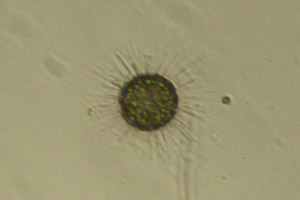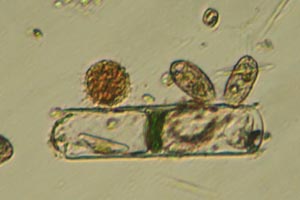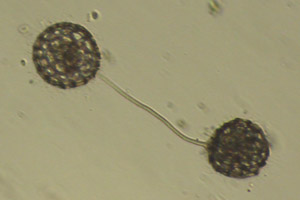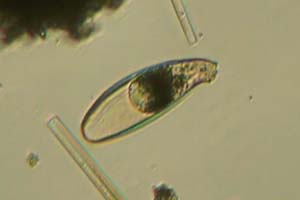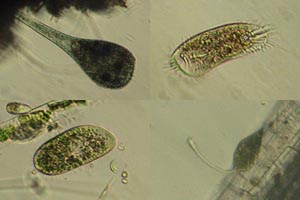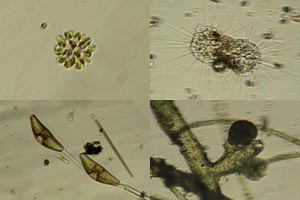Chromists vary from single-celled organisms to giant multicellular seaweeds. Many have chloroplasts, which were originally derived from an enclosed red alga, but have their own distinct pigments and are usually yellowish or brown. These are characteristically surrounded by one or two extra membranes, not free in the cell like in true plants.
Some of these algae have cell walls, including larger plant-like kinds like kelp, but others have inorganic shells, scales, or lack cell coverings. These include some cells with mixed nutrition, engulfing smaller bacteria and flagellates to supplement photosynthesis with nutrients like nitrogen.
Other chromists lack chloroplasts and feed by ingestion or absorption, including many traditionally considered protozoans. In several groups prey are captured using temporary projections or pseudopodia, which are typically thread- or needle-like. Some others have a definite cell mouth or live as parasites.
Haptista are single cells with adhesive projections and often scales, separated into mostly marine algae and mostly freshwater heliozoans. The latter are round amoebae with no plastids or flagella, relying on radiate projections in the form of needle-like axopodia to slowly move about and capture food.
This same basic form has appeared in a few different groups of chromists. Centrohelea here have relatively fine axopodia connected to a central granule, and in most the cell is covered by various scales, spicules, or a gelatinous coat.
Acanthocystis
Greek akantha, thorn, kystis, bladder
Angl. a-KAN-tho-SIS-tis
Acanthocystis have a coat of silicate scales and one or two lengths of spicules, directed straight out with pointed or forked ends. They often host green zoochlorellae.
Cercozoa are mainly flagellates and amoebae that use thin projections to collect food. These generally take the form of thread-like filopodia, though some have axopodia or other forms. Most move along surfaces, either by using a trailing flagellum for gliding or by dragging the cell body forward.
Vampyrella
Serbian vampir, vampire
Angl. VAM-pi-REL-a
Vampyrella are round amoebae with thin radiate filopodia. They feed on filamentous algae by breaking through the cell wall, and are typically orange from ingested pigments.
Clathrulina
Greek kleithra or klathra, bars
Angl. KLATH-ru-LYE-na
Clathrulina secrete spherical capsules, leaving openings around their radiate axopodia. They also form tubular stalks and sometimes are attached in small groups.
Imbricatea have a cell covering of silicate scales. Along with some small flagellates, they include the Euglyphida, filose amoebae where these scales are assembled into a shell. The cell extends through a single opening for movement and feeding, and ultimately forms a matching shell outside it before dividing.
Cyphoderia
Greek kyphos, hunched, derē, neck
Angl. SYE-fo-DEER-eea
Cyphoderia have elongate shells that are slightly bent at one end, where they open. The scales are hidden in an organic cement, which gives it a yellowish-brown tinge.
Ciliates are among the most common of the larger single-celled organisms. Most have a distinct mouth and many short flagella, called cilia, arranged in rows or compound tufts.
Classes included here: Karyorelictea,
Heterotrichea,
Litostomatea,
Armophorea,
Spirotrichea,
Phyllopharyngea,
Nassophorea,
Colpodea,
Prostomatea,
Oligohymenophorea
Miozoa are a large group of parasites and related flagellates. They have vesicles called alveoli supporting the cell membrane, shared by ciliates, and often an apical structure variously adapted to infecting, sucking fluids from, or ingesting other cells. Plastids are common but photosynthesis is rare except in dinoflagellates.
Most dinoflagellates have two flagella set in grooves. One, the cingulum, runs around the cell so the flagellum propels it with a characteristic whirling motion. The other runs to the posterior with the flagellum serving in steering. Chloroplasts are mostly golden-brown, and some also have armour plates formed within the alveoli.
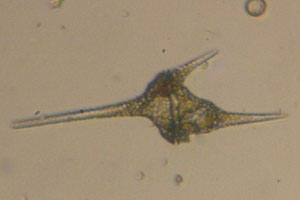
Kootenay Lake, British Columbia - about 170 µm
Ceratium
Greek keras, horn, -ion, dimn.
Angl. se-RAY-sheeum
Ceratium have armour drawn out into long spines, with one anterior to the cingulum and two or three behind it. They occur in freshwater, but some marine relatives are similar.
Ochrophyta are a major group of mostly brownish algae. Like simple plants, they include single cells, colonies and filaments, and even some large complex seaweeds like kelp.
Classes included here: Chrysophyceae,
Raphidophyceae,
Xanthophyceae,
Diatomeae
